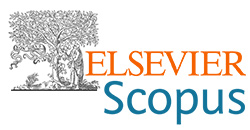Photocatalytic degradation of textile dye with titanium (IV) doped tungsten oxide nanoparticles
DOI:
https://doi.org/10.62638/ZasMat1037Abstract
Water pollution from textile industries is a major concern with respect to the availability of clean drinking water. The removal of textile (organic) dyes through photocatalytic degradation with pure WO3 and titanium (IV) doped tungsten oxide [Ti (IV)-WO3] nanospheres were studied under visible light. The WO3 and Ti (IV)-WO3 nanospheres were synthesized via microwave-assisted method at microwave power of 160 W for the duration of 20 mins. The as synthesised WO3 and Ti (IV)-WO3 nanospheres were characterized for their structural, microstructural, and spectroscopic properties by using powder X-ray diffraction (XRD), UV–Visible (UV-Vis) spectroscopy, Fourier-transform infrared spectroscopy (FTIR), Scanning electron microscopy (SEM) and High-resolution transmission electron microscopy (HR-TEM). The X-ray diffractograms confirmed the formation of highly pure WO3 and Ti (IV)-WO3 nanospheres. The average crystallite size of WO3 and Ti (IV)-WO3 nanospheres were calculated as 53.37 nm and 35.24 nm respectively using Debye Scherrer equation. The bandgap of Ti (IV)-WO3 was found to be decreased to 2.5 eV from 3.2 eV (WO3) respectively. It can be deduced that Ti (IV)-WO3 can be utilized as efficient visible light (λ>420 nm) driven photocatalyst as the bandgap was < 3 eV. The agglomerated spherical nanoparticles were seen for WO3 and Ti (IV)-WO3 in the HR-TEM images. The photocatalytic activity of textile dye was analyzed by UV-Vis spectrophotometer under visible light. The photocatalytic organic dye degradation was investigated. The enhanced photocatalytic activity of titanium (IV) doped tungsten oxide (10 wt%) was observed to be ~100% in 100 mins. This makes titanium (IV) doped tungsten oxide nanospheres, a potential nanomaterial for water purification.
Keywords:
Photocatalytic degradation, organic dyes, microwave assisted method, photocatalytic activityReferences
R.Gusain, K.Gupta, P.Joshi, O.P.Khatri (2019) Adsorptive removal and photocatalytic degradation of organic pollutants using metal oxides and their composites: A comprehensive review, Advances in colloid and interface science, 272, 102009.
https://doi.org/10.1016/j.cis.2019.102009
B.Lellis, C.Z.Fávaro-Polonio, J.A.Pamphile, J.C. Polonio (2019) Effects of textile dyes on health and the environment and bioremediation potential of living organisms, Biotechnology Research and Innovation, 3(2), 275-290.
https://doi.org/10.1016/j.biori.2019.09.001
M.Saeed, M.Muneer, A.U.Haq, N.Akram (2022) Photocatalysis: An effective tool for photo-degradation of dyes-A review, Environmental Science and Pollution Research, p.1-19.
https://doi.org/10.1007/s11356-021-16389-7
A.Rafiq, M.Ikram, S.Ali, F.Niaz, M.Khan, Q.Khan, M.Maqbool (2021) Photocatalytic degradation of dyes using semiconductor photocatalysts to clean industrial water pollution, J. of Industrial and Engineering Chemistry, 97, 111-128.
https://doi.org/10.1016/j.jiec.2021.02.017
M.Elangovan, S.M.Bharathaiyengar, J.Ponnan Ettiyappan (2021) Photocatalytic degradation of diclofenac using TiO2-CdS heterojunction catalysts under visible light irradiation, Environmental Science and Pollution Research, 28, 18186-18200.
https://doi.org/10.1007/s11356-020-11538-w
H.Yuan, Y.Zhu, Q.Xu (2020) Research Progress of Bi-Based Catalysts for Photocatalytic Oxidation of VOCs, Hans Journal of Chem. Engin. and Techn., 10(2), 73-81.
https://doi.org/10.12677/HJCET.2020.102011
N.A.Rajpurohit, K.Bhakar, M.Nemiwal, D.Kumar (2022) Design and synthesis of hybrid nanostructures for sustainable energy and environmental remediation, Arabian Journal of Geosciences, 15, 1-16.
https://doi.org/10.1007/s12517-022-09456-x
C.Feng, S.Wang, B.Geng (2011) Ti (iv) doped WO3 nanocuboids: fabrication and enhanced visible-light-driven photocatalytic performance, Nanoscale, 3(9), 3695-3699.
https://doi.org/10.1039/c1nr10460h
F.Heshmatpour, F.S.Seyed Atashi (2023) Synthesis and characterization of iron-based spinel nanoparticles with different coatings and their ability in photocatalytic degradation of methylene blue, J. of Applied Chemistry, 18(68), 9-28.
T.L.Nguyen, V.D.Quoc, T.L.Nguyen, T.T.T.Le, T.K.Dinh, P.H.Nguyen (2021) Visible-Light-Driven SO42-/TiO2 Photocatalyst Synthesized from Binh Dinh (Vietnam) Ilmenite Ore for Rhodamine B Degradation, J. of Nanomaterials, 2021, 1-13.
https://doi.org/10.1155/2021/8873181
U.Aarthi, D.Shukla, S.Rengaraj, K.S.Babu (2020). Ordered to defect fluorite structural transition in Ce1-xNdxO2-δ system and its influence on ionic conductivity, J. of Alloys and Compounds, 838, 155534.
https://doi.org/10.1016/j.jallcom.2020.155534
K.Yin, Y.Shen (2020) Theoretical insights into CO2 hydrogenation to HCOOH over FexZr1-xO2 solid solution catalyst, Applied Surface Science, 528, 146926.
https://doi.org/10.1016/j.apsusc.2020.146926
N.Moghni, H.Boutoumi, H.Khalaf, N.Makaoui, G.Colón (2022) Enhanced photocatalytic activity of TiO2/WO3 nanocomposite from sonochemical-microwave assisted synthesis for the photodegrada¬tion of ciprofloxacin and oxytetracycline antibiotics under UV and sunlight, J. of Photochemistry and Photobiology A: Chemistry, 428, 113848.666.
https://doi.org/10.1016/j.jphotochem.2022.113848
H.Ijadpanah-Saravy, M.Safari, A.Khodadadi-Darban, A.Rezaei (2014) Synthesis of titanium dioxide nanoparticles for photocatalytic degradation of cyanide in wastewater, Analytical Letters, 47(10), 1772-1782.
https://doi.org/10.1080/00032719.2014.880170
I.A.De Castro, J.A.De Oliveira, E.C.Paris, T.R. Giraldi, C.Ribeiro (2015) Production of heterostructured TiO2/WO3 Nanoparticulated photocatalysts through a simple one pot method, Ceramics International, 41(3), 3502-3510.
https://doi.org/10.1016/j.ceramint.2014.11.001
C.H.Su, C.Y.Su, Y.F.Lin (2015) Microstructural characterization and field emission properties of tungsten oxide and titanium-oxide-doped tungsten oxide nanowires, Materials Chemistry and Physics, 153, 353-358.
https://doi.org/10.1016/j.matchemphys.2015.01.025
B.Singaram, J.Jeyaram, R.Rajendran, P. Arumugam, K.Varadharajan (2019) Visible light photocatalytic activity of tungsten and fluorine codoped TiO2 nanoparticle for an efficient dye degradation, Ionics, 25, 773-784.
https://doi.org/10.1007/s11581-018-2628-x
J.Y.Zhang, I.W.Boyd, B.J.O'sullivan, P.K.Hurley, P.V.Kelly, J.P.Senateur (2002) Nanocrystalline TiO2 films studied by optical, XRD and FTIR spectroscopy, J. of Non-Crystalline Solids, 303(1), 134-138.
https://doi.org/10.1016/S0022-3093(02)00973-0
S.A.Singh, G.Madras (2013) Photocatalytic degradation with combustion synthesized WO3 and WO3TiO2 mixed oxides under UV and visible light, Separation and Purification Technology, 105, 79-89.
https://doi.org/10.1016/j.seppur.2012.12.010
İ.Ç.Davaslıoğlu, K.V.Özdokur, S.Koçak, Ç.Çırak, B.Çağlar, B.B.Çırak, F.N.Ertaş (2021) WO3 decorated TiO2 nanotube array electrode: Prepara-tion, characterization and superior photoelectro-chemical performance for rhodamine B dye de-gradation, J. of Molecular Structure, 1241, 130673.







